Recipes & Culinary Uses
What Does a Butter Knife Look Like in Different Cultures?
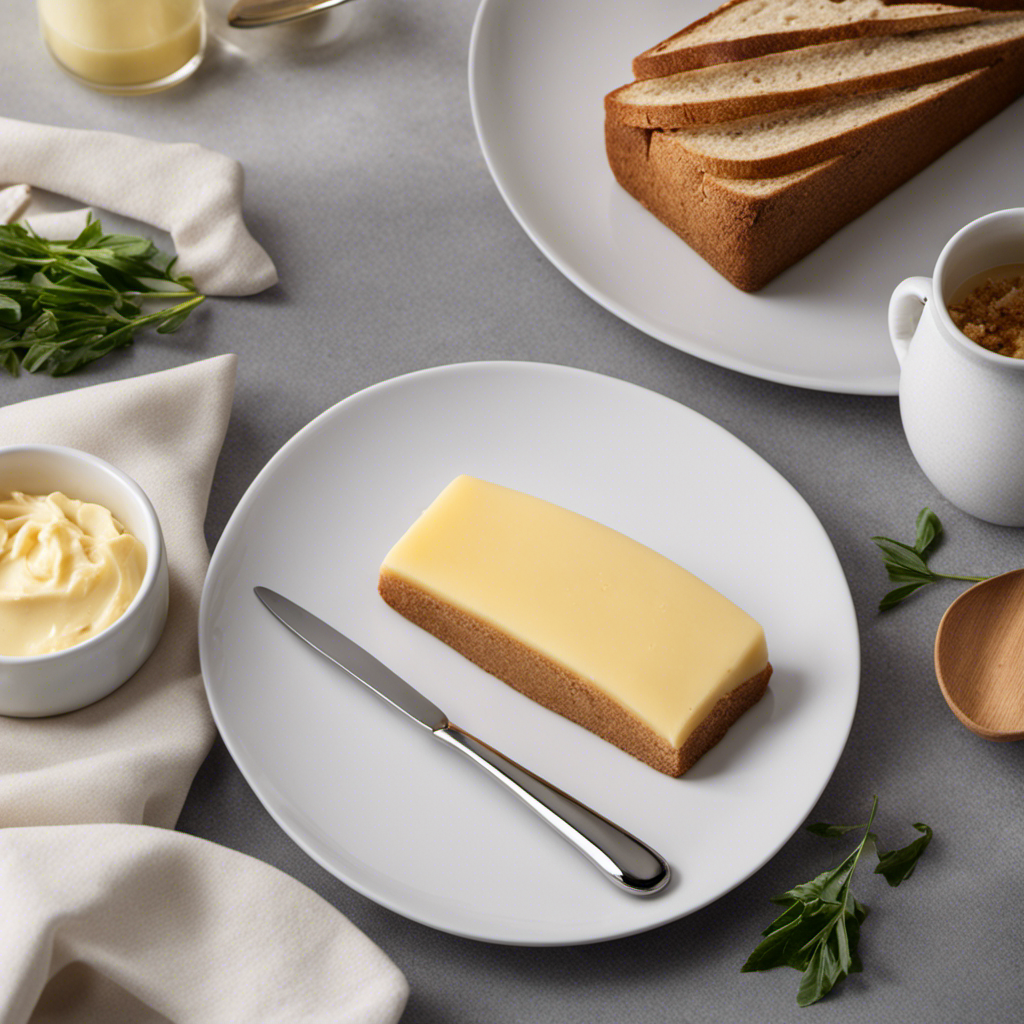
Every morning, as I smear smooth butter on my hot toast, I can’t help but appreciate the often overlooked hero of my kitchen – the butter knife. This simple tool, with its slim blade and rounded end, effortlessly cuts through the rich goodness, making it the perfect partner for any breakfast enthusiast.
In this article, I’ll take you on a journey to explore the history, types, materials, and features of butter knives, as well as share tips on how to use and care for them.
So, let’s embark on this buttery adventure together!
Key Takeaways
- Butter knives have evolved over time, from being made from bone or wood to silver and stainless steel, with the addition of a serrated edge for cutting through refrigerated butter.
- There are different types of butter knives with various blade shapes, including curved, straight, and serrated, to accommodate different spreading and cutting preferences.
- Butter knives can have handles made from a variety of materials such as wood, stainless steel, and plastic, offering different textures and aesthetics.
- To maintain butter knives, they should be stored in a dry place, kept away from moisture and humidity, and regularly cleaned and oiled to prevent rust.
History of Butter Knives
If you’re interested in the history of butter knives, you might be surprised to learn that they have been used for centuries. The origins of butter knives can be traced back to ancient civilizations, where they were used as a tool to spread butter onto bread or other food items.
These early butter knives were typically made from natural materials such as bone or wood. As time went on, the evolution of butter knives saw the introduction of new materials like silver and stainless steel, making them more durable and elegant. The design of butter knives also evolved, with the addition of a serrated edge to easily cut through butter straight from the refrigerator.
Today, butter knives come in various shapes and sizes, but their purpose remains the same – to effortlessly spread butter onto our favorite foods.
Types of Butter Knives
When it comes to butter knives, there is more to consider than just their history and appearance.
Two key factors that can greatly affect your butter knife experience are blade shape preferences and handle material options.
The shape of the blade can determine how easily you can spread butter, while the material of the handle can impact the knife’s durability and comfort in your hand.
Let’s dive deeper into these aspects to help you find the perfect butter knife for your needs.
Blade Shape Preferences
You might prefer a butter knife with a curved blade shape for easier spreading. The curved blade allows you to effortlessly glide through butter, making it a popular choice among many.
However, blade shape preferences vary from person to person. Some may prefer a straight blade for precision cutting, while others may opt for a serrated blade for easily spreading thick spreads like peanut butter.
When it comes to handle material variations, there are countless options available. From traditional wooden handles to modern stainless steel ones, the choice is ultimately a matter of personal preference.
Some may prefer the warmth and natural feel of wood, while others may appreciate the durability and sleekness of stainless steel. The handle material can greatly affect the overall look and feel of the butter knife, so choose wisely based on your own preferences and needs.
Handle Material Options
For a classic and timeless look, consider opting for a butter knife with a handle made of polished wood. Wood handles add warmth and elegance to the table setting, making them a popular choice for traditional and rustic-themed occasions. They also provide a comfortable and secure grip, ensuring a smooth and controlled spread of butter or jam.
In comparison, plastic handles may lack the same level of sophistication, but they offer practicality and affordability. On the other hand, metal handles exude a sleek and modern aesthetic, while ceramic handles can add a touch of whimsy and uniqueness.
Ultimately, the choice between wood, plastic, metal, or ceramic handles depends on personal preference and the desired atmosphere for the dining experience.
Materials Used in Butter Knives
Butter knives are typically made from stainless steel or silver. Precision and attention to detail are key in the manufacturing process. Here are some materials used in butter knife production that contribute to their durability and functionality:
- Stainless Steel: This popular material is known for its resistance to corrosion and rust, making it perfect for everyday use.
- Silver: Often used for luxury butter knives, silver adds an elegant touch to the dining experience.
- Handle Materials: From wood to plastic, the handle of a butter knife can vary in material, providing different textures and aesthetics.
Using a butter knife has several benefits. It allows for easy spreading of butter or other spreads on bread or toast. The smooth, rounded edge prevents tearing or squishing of delicate baked goods. Additionally, the flat blade enables even distribution of the spread for a consistent taste in every bite.
Now that we’ve covered the materials used in butter knives, let’s delve into the features and design that make them essential tools in the kitchen.
Features and Design of Butter Knives
When it comes to butter knives, there are a variety of options to consider. Blade shape is one factor to think about, with options ranging from the classic rounded tip to the more modern pointed tip. Each shape offers its own advantages and style.
In addition to blade shape, handle materials also vary. There is a wide range available, including wood, stainless steel, and even plastic. This allows for customization and personal preference when choosing a butter knife.
For those looking to add a touch of elegance to their butter knife, there are many decorative embellishments available. Engraved patterns or ornate handle designs can make the knife not just a functional tool, but a beautiful one as well.
Blade Shape Options
Have you ever considered what options there are for the shape of a butter knife blade? When it comes to butter knives, blade shape options are surprisingly diverse.
Here are three examples to help you visualize the possibilities:
-
Straight Blade: The classic choice, with a straight and flat blade, perfect for spreading butter or jam evenly on your toast.
-
Pointed Blade: This blade shape features a pointed tip, which allows for easy piercing of bread or pastries, making it ideal for cutting and spreading.
-
Serrated Blade: With a saw-like edge, this blade shape effortlessly glides through crusty bread, while still providing a smooth spreading surface for your butter or toppings.
Now that we’ve explored the various blade shape options, let’s move on to another important aspect of butter knives: handle material variations.
Handle Material Variations
Now that we’ve explored the different blade shapes available for butter knives, let’s shift our focus to another important aspect: handle material variations.
The handle of a butter knife not only contributes to its overall aesthetics but also plays a crucial role in its durability.
When it comes to handle materials, there are several options to choose from. Common materials include stainless steel, wood, plastic, and even bone or ivory for more luxurious options. Each material offers its own unique set of benefits.
Stainless steel handles are known for their strength and durability, while wooden handles add a touch of natural beauty. Plastic handles are often lightweight and easy to clean.
Finding the perfect handle material is essential for both functionality and style. As we delve into the world of butter knife design, it’s important to consider the handle material’s durability and aesthetics.
Now that we have covered handle materials, let’s move on to the next exciting aspect: the decorative embellishments available.
Decorative Embellishments Available
Let’s explore the various decorative embellishments available for butter knives, adding a touch of elegance and personal style to these essential kitchen tools. When it comes to decorative handle options, the possibilities are endless. Here are a few ideas to spark your imagination:
-
Intricate carvings: Imagine a butter knife with a beautifully carved handle, featuring delicate patterns and motifs. It adds a touch of sophistication to your table setting.
-
Embossed designs: Picture a butter knife with a raised design on its handle, such as floral patterns or geometric shapes. It creates a tactile and visually appealing experience.
-
Inlay work: Visualize a butter knife with inlaid materials like mother-of-pearl or wood, adding a unique and luxurious touch to the handle.
In addition to decorative handles, unique blade designs can also make a statement. From serrated edges to scalloped blades, these variations offer both functionality and aesthetic appeal. So why settle for a plain butter knife when you can elevate your dining experience with these decorative options?
How to Use a Butter Knife
Using a butter knife, you can easily spread butter or jam onto your toast. However, there are alternatives to a traditional butter knife that can make your spreading experience even better.
One option is a cheese spreader, which has a wider and flatter blade, perfect for spreading butter smoothly. Another alternative is a silicone spatula, which is flexible and can easily glide over your toast.
When using any type of knife for spreading, it’s important to follow some safety tips. Always hold the knife with a firm grip and be mindful of your fingers. Avoid using excessive force that could cause the knife to slip.
Additionally, make sure to clean and dry your knife properly after use to prevent any potential accidents.
Proper Care and Maintenance of Butter Knives
To keep your butter knife in good condition, it’s important to regularly clean and dry it after each use. Here are some tips on how to properly care for and maintain your butter knife:
- Store your butter knife in a dry place, away from moisture and humidity.
- Avoid leaving your butter knife in the sink or dishwasher for extended periods of time.
- To remove rust from your butter knife, soak it in a mixture of vinegar and water for a few hours, then scrub it gently with a sponge or brush.
- After cleaning, make sure to dry your butter knife thoroughly to prevent any moisture from causing rust.
- Regularly oil your butter knife with a food-safe oil to keep it lubricated and prevent rust.
Taking these simple steps will ensure that your butter knife stays in pristine condition and is always ready for spreading butter or other delicious toppings.
Now, let’s move on to some fun facts about butter knives.
Fun Facts About Butter Knives
Did you know that butter knives were originally designed to help spread butter on bread? It’s a fun fact about butter knives that many people may not be aware of. These versatile kitchen tools have been around for centuries and have evolved over time. Today, butter knives come in various shapes, sizes, and materials, but their purpose remains the same – to make spreading butter easier and more efficient.
Using a butter knife offers several benefits. Firstly, its blunt edge prevents accidents and injuries while spreading butter on bread. Additionally, the flat and wide blade allows for a smooth and even distribution of butter, ensuring each bite is perfectly buttered. Furthermore, butter knives can also be used for other purposes in the kitchen, such as spreading condiments, frosting cakes, or even cutting soft cheeses. So, next time you reach for a butter knife, remember its humble beginnings and enjoy the convenience and versatility it brings to your culinary adventures.
| Fun Facts About Butter Knives | Benefits of Using a Butter Knife | Did you know that butter knives were originally designed to help spread butter on bread? It’s a fun fact about butter knives that many people may not be aware of. These versatile kitchen tools have been around for centuries and have evolved over time. Today, butter knives come in various shapes, sizes, and materials, but their purpose remains the same – to make spreading butter easier and more efficient. | Using a butter knife offers several benefits. Firstly, its blunt edge prevents accidents and injuries while spreading butter on bread. Additionally, the flat and wide blade allows for a smooth and even distribution of butter, ensuring each bite is perfectly buttered. Furthermore, butter knives can also be used for other purposes in the kitchen, such as spreading condiments, frosting cakes, or even cutting soft cheeses. So, next time you reach for a butter knife, remember its humble beginnings and enjoy the convenience and versatility it brings to your culinary adventures. |
|---|
Frequently Asked Questions
Can a Butter Knife Be Used for Anything Other Than Spreading Butter?
A butter knife can be used for more than just spreading butter. It has many creative uses, such as slicing through soft cheeses, spreading condiments, or even cutting delicate cakes. It’s a versatile tool in the kitchen.
Are There Any Safety Precautions to Keep in Mind When Using a Butter Knife?
When using a butter knife, it’s important to take safety precautions and handle it properly to avoid accidents. Always hold it by the handle and avoid applying excessive force to prevent injuries.
Can a Butter Knife Be Used as a Substitute for Other Kitchen Utensils?
Sure, a butter knife can be used as a substitute for other kitchen utensils in a pinch. I’ve used it to spread mayo, cut soft fruits, and even open packages. It’s a versatile tool!
Are There Any Specific Guidelines for Choosing the Right Butter Knife for Different Types of Butter?
Choosing the right butter knife for different types of butter can enhance your dining experience. From spreading cold butter to slicing through soft butter, a good butter knife should be versatile and comfortable to use.
Are There Any Alternative Materials Used in the Making of Butter Knives That Are More Sustainable or Eco-Friendly?
Sustainable alternatives to traditional butter knives are becoming more popular. Eco-friendly materials like bamboo or recycled stainless steel are being used, reducing environmental impact. These knives are not only functional but also visually appealing.
Conclusion
In conclusion, butter knives are essential tools in any kitchen. They come in various types, materials, and designs, each serving its unique purpose.
From the history of butter knives to the proper care and maintenance, we’ve covered it all.
So, the next time you reach for that trusty butter knife, remember its humble beginnings and the incredible versatility it offers. It’s like a magical wand, effortlessly spreading butter on toast, making your breakfast experience out of this world!
Get ready to embrace the butter knife’s power and elevate your culinary adventures.
Sunny’s articles radiate enthusiasm, much like her sunny disposition. As our resident “Butter Geek”, she delves deep into the latest butter trends, ensuring our readers are always in the know. Beyond her writing, Sunny’s passion lies in exploring vegan butter alternatives and hosting butter-tasting soirées.
Recipes & Culinary Uses
Creamy Delight: Best Butter Pecan Ice Cream Recipe for Summer!
Yearning for a creamy summer treat that will leave you craving more?
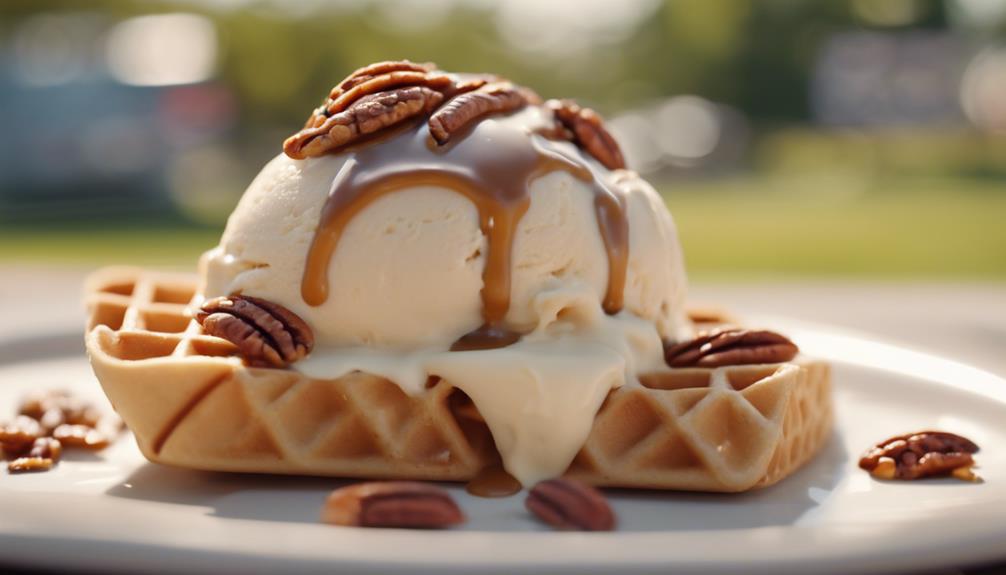
Savor a delicious summer treat with our Butter Pecan Ice Cream recipe. Mix butter, brown sugar, cream, and pecans for a creamy delight. Melt butter, cook pecans, whisk eggs, and blend for a rich flavor. Add pecans, cream, and vanilla, then freeze to perfection. Master this easy-to-follow recipe for a tasty dessert to beat the heat.
Key Takeaways
- Rich and creamy blend of butter, brown sugar, and heavy cream
- Toasted pecans for a nutty crunch and flavor
- Easy-to-follow steps for homemade ice cream perfection
- Customization options with variations like bourbon or chocolate
- Perfect summer treat with a decadent, refreshing taste
Recipe Ingredients for Butter Pecan Ice Cream
To create a delectable batch of butter pecan ice cream, gather the essential ingredients listed in the recipe.
You'll need:
- Butter
- Brown sugar
- Heavy cream
- Pecans
These ingredients combine to bring out the rich and nutty flavors of this classic dessert.
The brown sugar adds a caramel-like sweetness, while the heavy cream contributes to a creamy texture that's essential for a decadent treat.
Pecans, when toasted in butter, provide a delightful crunch and enhance the overall flavor profile of the ice cream.
Cooking Instructions for Homemade Ice Cream
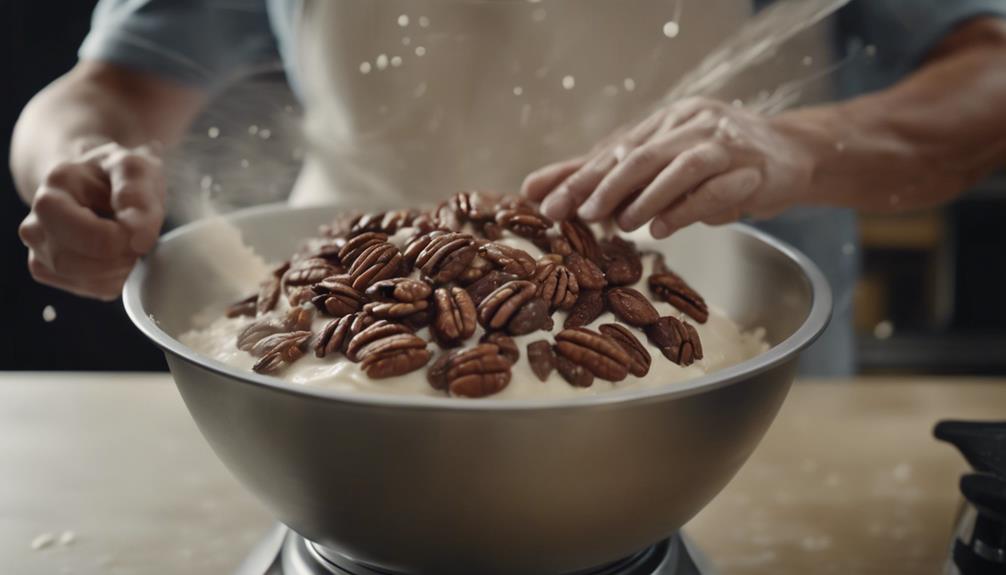
Start by melting butter in a skillet to infuse the pecans with a rich, nutty flavor for your homemade butter pecan ice cream.
Here's a quick guide to help you make this creamy delight:
- Melt butter and cook pecans for flavor.
- Whisk eggs and combine with half-and-half and brown sugar for a creamy base.
- Cook until thickened, then mix with eggs in a bowl.
- Add cream, pecans, and vanilla extract.
- Freeze the mixture in an ice cream maker.
Following these steps will guarantee your homemade butter pecan ice cream turns out rich and delicious.
Remember to carefully adhere to the manufacturer's instructions for your ice cream maker to achieve the perfect consistency.
Enjoy the process of creating this delightful treat that will surely be a hit during the summer months.
Ice Cream Preparation Steps

Mix half and half with brown sugar over medium heat in a large bowl to prepare the ice cream base.
Next, whisk beaten eggs and temper them with the warm milk mixture to create a smooth custard.
Once done, thicken the mixture on low heat, then cool it over an ice bath to achieve ideal texture.
After that, stir in heavy cream, vanilla extract, maple extract, and a pinch of salt for rich flavor.
Remember to refrigerate the mixture for 1 1/2 – 2 hours before churning it into creamy butter pecan ice cream.
This process ensures that the flavors meld together beautifully and the ice cream attains the perfect consistency for scooping and savoring.
Nutritional Information and Tips
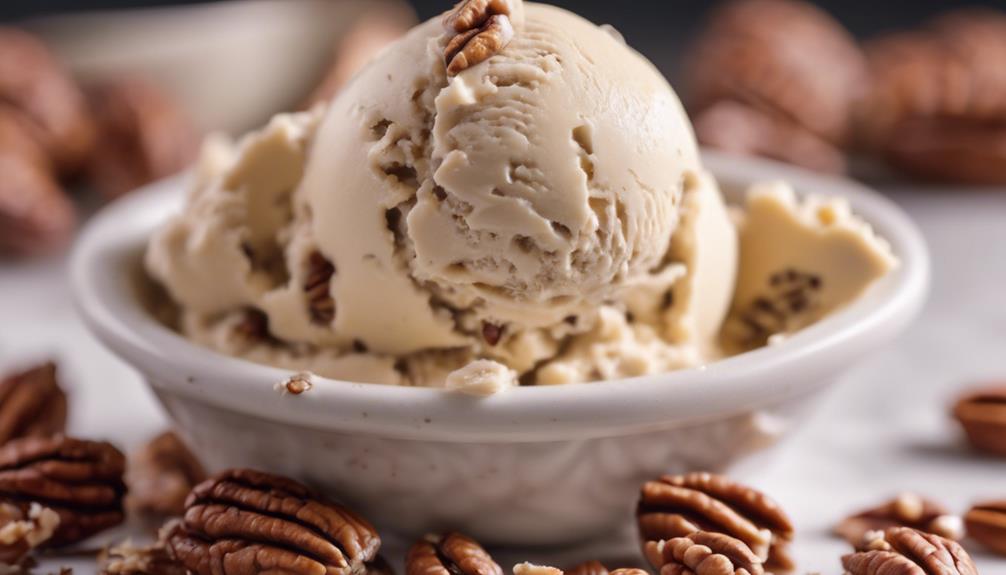
Considering the rich and creamy nature of homemade butter pecan ice cream, it's important to be mindful of its nutritional content and serving size. When indulging in this delectable dessert, remember these essential tips:
- Portion Control: Enjoy in moderation to savor the flavors without overindulging.
- Brown Sugar Sweetness: Opt for a moderate amount of brown sugar to balance sweetness without overwhelming the palate.
- Room Temperature Ingredients: Confirm ingredients like butter and heavy cream are at room temperature for a smoother texture.
- Nutritional Awareness: Be mindful that homemade butter pecan ice cream can vary in nutritional content, so adjust ingredients accordingly.
- Consultation: Seek advice from a nutritionist or healthcare provider for personalized guidance on incorporating this treat into a balanced diet.
Homemade Butter Pecan Ice Cream Variations
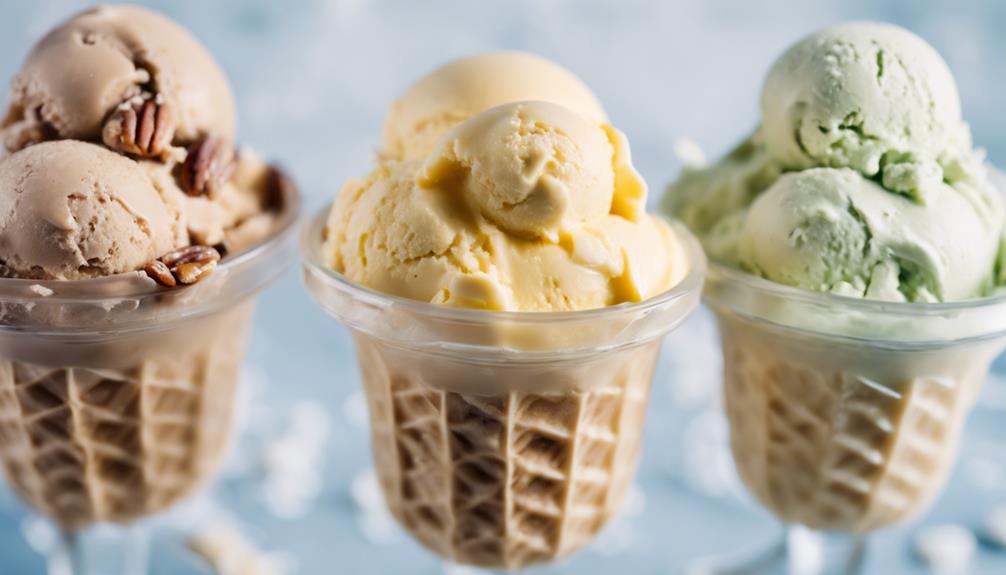
Explore creative twists on traditional butter pecan ice cream by incorporating different nuts, spirits, sauces, chocolates, and dairy-free alternatives.
For a unique flavor, try substituting pecans with walnuts or almonds in the full recipe. Toast the nuts in a separate bowl until browned and fragrant, then chop them finely enough to coat in the ice cream mixture.
To add a boozy kick, mix in a splash of bourbon or rum to the base as you churn the ice cream. For an extra indulgent touch, swirl in caramel sauce or fudge ripple throughout the mixture.
Incorporate chunks of chocolate or chocolate-covered nuts for a delightful contrast in texture, giving each bite a sweet surprise.
If you prefer a lighter, dairy-free option, consider using coconut milk or almond milk as a substitute for traditional dairy products. These alternatives provide a creamy base while catering to plant-based diets.
Experiment with these variations to create a personalized butter pecan ice cream that suits your taste preferences.
Frequently Asked Questions
What Is the Secret to Making Ice Cream Very Creamy?
To make ice cream very creamy, you use a rich base of ingredients like heavy cream, eggs, and sugar. Chilling the base before churning is crucial for a smoother texture. Adding vanilla extract enhances creaminess, and slow churning prevents a dense outcome.
What Flavor Is the Ice Cream in Butter Pecan?
The ice cream in butter pecan is a delightful blend of buttery richness, vanilla sweetness, and maple undertones, perfectly paired with toasted pecans for a nutty crunch. This flavor combination creates a harmonious and indulgent treat.
What's the Difference Between Butter Pecan Ice Cream and Praline Pecan Ice Cream?
In butter pecan ice cream, you'll savor the buttery richness of pecans blended with a creamy base. On the other hand, praline pecan ice cream highlights caramelized sweetness with a swirl of praline sauce for a delightful flavor contrast.
What Age Group Eats Butter Pecan Ice Cream?
You'll find that adults and older individuals, typically in the 30-60 age group, enjoy butter pecan ice cream. It's a favorite among those with a more refined palate, drawn to its rich and nutty flavor.
Conclusion
So there you have it, folks! Whip up this buttery, nutty delight for a taste of summer in every scoop.
Don't cry over spilled milk – grab a cone and enjoy this creamy treat that's sure to satisfy your sweet tooth.
Get churning and indulge in the best butter pecan ice cream you've ever tasted!
Sunny’s articles radiate enthusiasm, much like her sunny disposition. As our resident “Butter Geek”, she delves deep into the latest butter trends, ensuring our readers are always in the know. Beyond her writing, Sunny’s passion lies in exploring vegan butter alternatives and hosting butter-tasting soirées.
Recipes & Culinary Uses
Festive Favorites: Best Peanut Butter Blossoms Recipe for Holidays!
Unleash the ultimate holiday baking magic with the best Peanut Butter Blossoms recipe – an irresistible treat that will elevate your festive celebrations!

Elevate your holiday baking with the ultimate Peanut Butter Blossoms recipe. Cream together peanut butter, butter, sugars, and salt, then add egg and vanilla. Roll dough into balls, coat in brown sugar, bake until golden, then press a Hershey's kiss on top. Adjust baking time as needed. Explore ingredient swaps for a personalized touch. Enjoy with hot cocoa or pair with savory dishes. For more tips, ideas, and customization options, the recipe holds more festive surprises.
Key Takeaways
- Cream together peanut butter, butter, sugars for rich flavor.
- Bake at 375°F for 8-10 minutes for soft, chewy cookies.
- Customize with ingredient swaps like almond butter or maple syrup.
- Pair with savory dishes or hot cocoa for holiday enjoyment.
- Press Hershey kisses onto warm cookies for a classic finish.
Ingredients for Peanut Butter Blossoms
For the classic Peanut Butter Blossoms recipe, gather peanut butter, butter, sugar, an egg, and Hershey's kisses as your essential ingredients.
Peanut butter is the star, offering a rich flavor that blends perfectly with the sweetness of the cookies.
Butter plays a pivotal role by adding moisture and richness to the dough, ensuring a soft and chewy texture.
The sugar not only sweetens the cookies but also contributes to their festive appeal, making them a perfect treat for any occasion.
Finally, the Hershey's kisses on top provide a delightful chocolatey finish that elevates these cookies to a whole new level of deliciousness.
Together, these ingredients create a harmonious blend of flavors and textures that make Peanut Butter Blossoms a beloved classic for holiday baking or any time you crave a sweet and satisfying treat.
Recipe Steps for Peanut Butter Blossoms
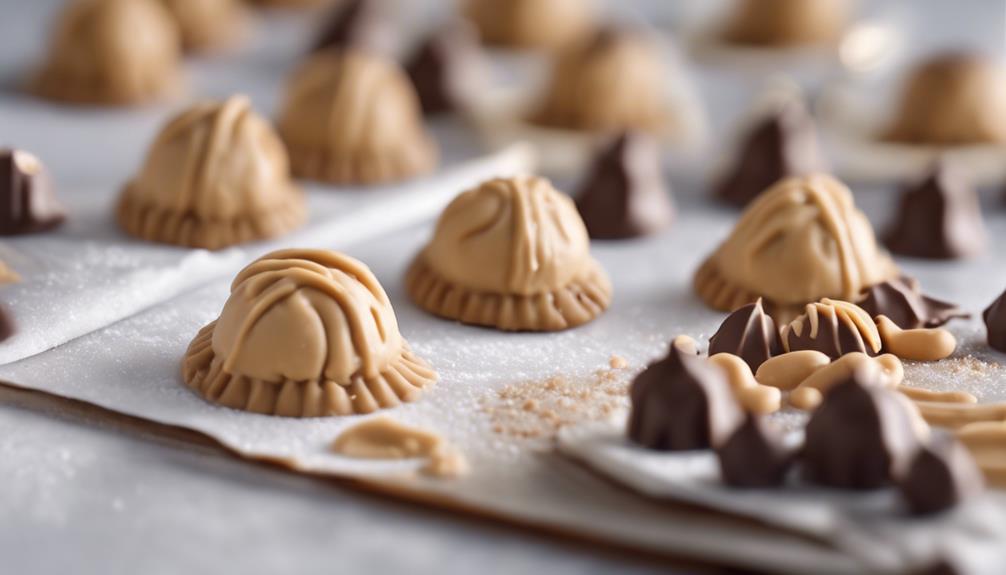
To make Peanut Butter Blossoms, start by creaming together peanut butter, butter, sugars, and salt until light and fluffy.
Next, add in the egg and vanilla extract, making sure to mix well to combine all the ingredients thoroughly.
Then, gradually incorporate the dry ingredients into the wet mixture until a smooth dough forms.
Once the dough is ready, roll it into balls and coat each ball generously in brown sugar.
Place the sugar-coated dough balls on a baking sheet, making sure to leave enough space between them for spreading during baking.
Bake the cookies in a preheated oven until they turn a beautiful golden brown.
As soon as the cookies are out of the oven, press a Hershey's kiss into the center of each cookie gently.
The heat from the freshly baked cookies will melt the chocolate just enough to adhere it to the cookie.
These Peanut Butter Blossoms are a delightful treat perfect for Christmas celebrations!
Pro Tips for Making Peanut Butter Blossoms
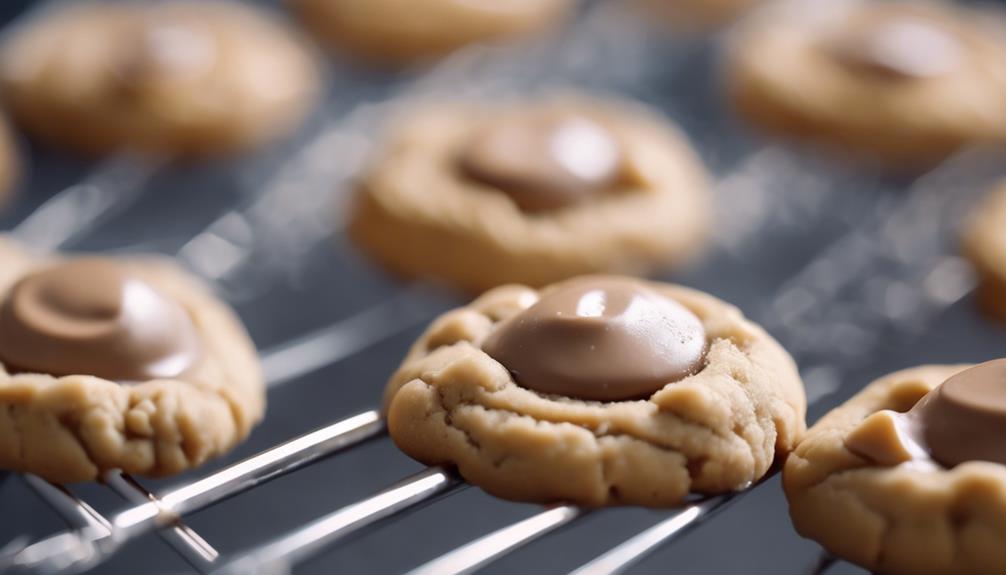
To enhance your peanut butter blossom baking experience, consider adjusting the baking time based on your oven's performance for best results.
Additionally, explore ingredient substitutions to cater to dietary preferences or allergies without compromising the flavor or texture of the cookies.
These pro tips can help you customize your peanut butter blossoms while ensuring delicious outcomes.
Baking Time Recommendations
Achieving the ideal texture for your peanut butter blossoms involves baking them at 375°F for 8-10 minutes. This baking duration guarantees that the cookies have a soft and chewy consistency while allowing the Hershey kisses on top to be softened but not completely melted.
Once out of the oven, remember to press the Hershey kisses onto the cookies immediately to secure them in place for that classic appearance.
For the best outcomes, chill the cookie dough for about 30 minutes before baking. This step helps the cookies maintain their shape and prevents excessive spreading during baking, ensuring your peanut butter blossom cookies are perfectly formed and ready to impress during your holiday baking.
Shortening or extending the baking time can alter the texture of the cookies. A quick bake of 6-8 minutes produces softer and chewier cookies, while longer baking times yield a slightly crispier consistency. Stick to the recommended 8-10 minutes for the best soft and chewy peanut butter blossoms.
Ingredient Substitutions
Consider incorporating different ingredients to elevate the flavor and nutritional profile of your peanut butter blossoms. For a healthier option, swap out shortening with unsalted butter to achieve a unique texture and taste in your cookies.
Try using natural peanut butter instead of creamy to add a wholesome twist to the classic recipe. If you're looking to reduce the glycemic impact, substitute brown sugar with coconut sugar in your baking. For a natural sweetener alternative, replace regular granulated sugar with maple syrup in the cookie dough mixture.
Additionally, for a distinct flavor experience, experiment with almond butter as a substitute for peanut butter in your blossoms. These ingredient substitutions can bring a new dimension to your peanut butter blossoms, making them not only delicious but also tailored to your dietary preferences.
Upgrade your baking game this holiday season with these creative twists on a beloved recipe!
Serving Suggestions for Peanut Butter Blossoms

Enhance the enjoyment of your peanut butter blossoms by pairing them with savory dishes like lasagna tortellini soup for a satisfying meal. These classic cookies also complement family-friendly dinners such as easy ground beef shepherd's pie and creamy broccoli cheddar soup, making for a delightful combination. The holiday season calls for cozy treats, and the sweet nuttiness of peanut butter blossoms pairs perfectly with a warm cup of hot cocoa. Whether you're participating in a cookie exchange or looking for a festive touch to your holiday dessert spread, consider rolling the cookies in red, green, and white sugar sprinkles to add a pop of color and fun.
| Serving Suggestions | Pairing Ideas |
|---|---|
| Lasagna Tortellini Soup | Comforting and hearty meal alongside the cookies |
| Easy Ground Beef Shepherd's Pie | Delicious combination for a family dinner |
| Creamy Broccoli Cheddar Soup | Perfect accompaniment to the nutty cookie flavors |
12 Days of Christmas Cookies Recipes
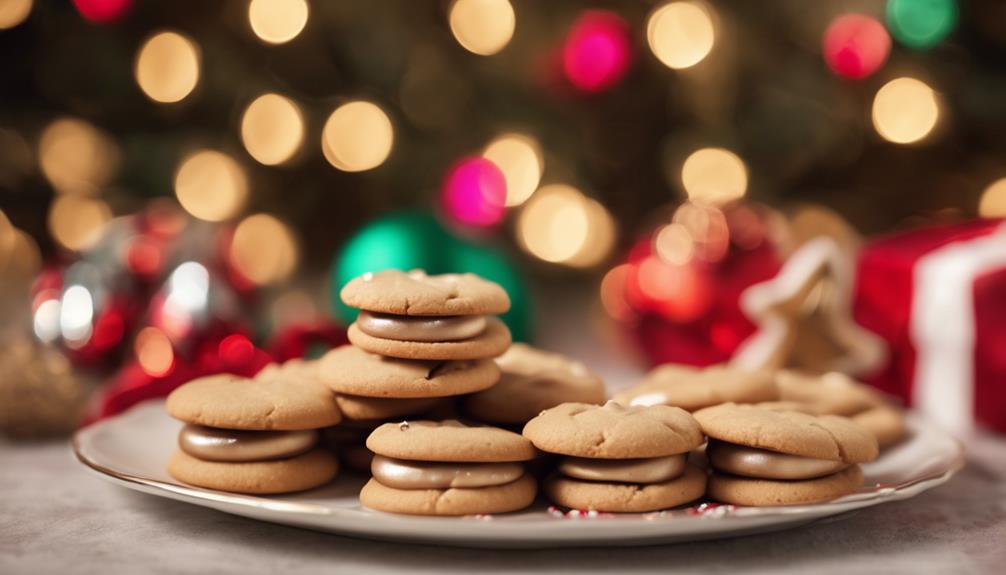
Indulge in a variety of delightful Christmas cookie recipes each day during the holiday season. One standout choice is the classic Peanut Butter Blossoms. These holiday cookies feature a peanut butter base topped with a Hershey's kiss, making them a beloved treat for cookie exchanges and festive gatherings.
The process of making these cookies is simple yet rewarding. Start by rolling the dough balls in sugar before baking to add a sweet crunch to each bite. The combination of rich peanut butter flavor and the chocolatey goodness of the Hershey's kiss creates a perfect balance of sweetness.
When enjoying these Christmas cookies, consider pairing them with a glass of milk for a classic and satisfying treat.
Whether you're baking them for your family, a cookie exchange, or a holiday party, Peanut Butter Blossoms are sure to be a hit. Make each day of the holiday season a little sweeter with these delicious cookies.
User Engagement Features
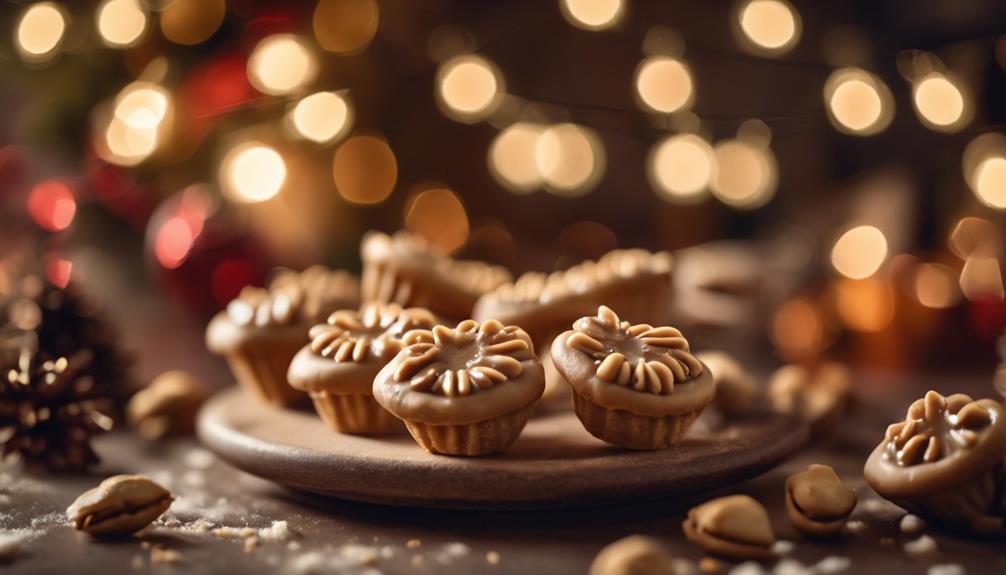
Let's talk about how user interaction features and personalization options enhance your experience with the Peanut Butter Blossoms recipe.
You can engage with others by leaving comments and sharing your results, creating a sense of community around this holiday treat.
Personalization options like name and email entry fields help tailor the experience to your preferences, making it more engaging and enjoyable.
User Interaction Features
Utilizing user engagement features on the website allows for increased participation and feedback from visitors. The comment section enables users to interact with each other and provide valuable feedback on the Peanut Butter Blossoms recipe or share their experiences with Hershey's kisses. By incorporating a reply option, users can engage in conversations, fostering a sense of community around baking these delightful peanut butter cookies.
Moreover, the inclusion of name and email fields not only allows for personalization but also facilitates communication between the website and its visitors. This data storage feature guarantees that users can conveniently access their information for future visits, enhancing their overall user experience.
These user engagement features play an essential role in creating an interactive platform where users can engage, provide feedback, and communicate effectively. Such interaction not only enriches the user experience but also encourages visitors to actively participate in the community surrounding the Peanut Butter Blossoms recipe.
Personalization Options
Enhance your website's user engagement by incorporating personalized options such as commenting, replying, and sharing feedback on the Peanut Butter Blossoms recipe. This level of user interaction not only fosters a sense of community building but also encourages customization and feedback. By allowing users to share their thoughts, results, and experiences with the festive favorites, you create a more engaging and interactive user experience. Additionally, providing users with the option to save their data for future visits and encouraging them to tag @preppykitchen and use #preppykitchen when trying the recipe further enhances their engagement.
| Personalization Options | Description | Benefits |
|---|---|---|
| Commenting | Users can leave comments on the Peanut Butter Blossoms recipe, sharing their thoughts and experiences. | Fosters community building and user engagement. |
| Replying | Users can reply to comments and engage in discussions with other users about the recipe. | Encourages active participation and interaction. |
| Feedback Sharing | Users can share feedback on the recipe, providing valuable insights for improvement. | Enhances user experience and customization. |
Additional Information

You may find it interesting to know more about the history of the Peanut Butter Blossoms recipe and its cultural significance during the holidays.
- The Peanut Butter Blossoms recipe's popularity is backed by IRI MULO data, making it a sought-after choice for holiday baking.
- Copyright for this beloved recipe belongs to The J.M. Smucker Company, a reputable name in the food industry known for quality products.
- These delightful cookies aren't only perfect for serving at holiday parties but also make excellent gifts due to their festive appeal.
Frequently Asked Questions
Why Are My Peanut Butter Blossoms Dry?
If your peanut butter blossoms are dry, it could be due to using too much flour, overbaking, using natural peanut butter that requires stirring, or not enough butter/shortening. Guarantee precise measurements and follow the recipe closely to maintain moisture.
Why Did My Peanut Butter Blossoms Go Flat?
When making peanut butter blossoms, going flat happens due to overmixing, too much flour, insufficient chilling, or low oven temperature. Remember to avoid these pitfalls. Preheat the oven properly and follow the recipe for perfect blossoms!
What Is America's Favorite Christmas Cookie?
America's favorite Christmas cookie is Peanut Butter Blossoms. Loved for their peanut butter-chocolate combo and nostalgic Hershey's Kiss center, these easy-to-make treats are a holiday staple at parties and gatherings. They're a must-have during the festive season.
What Is Baskin Robbins Peanut Butter Blossom?
You asked about Baskin Robbins Peanut Butter Blossom. It's a delectable seasonal ice cream flavor featuring creamy peanut butter ice cream with a ribbon of more peanut butter and chocolate cookie pieces. Indulge in this festive treat!
Conclusion
Indulge in the warm, gooey goodness of these peanut butter blossoms this holiday season. With the perfect blend of creamy peanut butter and rich chocolate, these cookies are sure to bring joy to your festivities.
Picture yourself surrounded by loved ones, sharing laughter and memories as you enjoy these delicious treats. Let the aroma of freshly baked cookies fill your home and create a cozy, festive atmosphere.
Happy baking and happy holidays!
Sunny’s articles radiate enthusiasm, much like her sunny disposition. As our resident “Butter Geek”, she delves deep into the latest butter trends, ensuring our readers are always in the know. Beyond her writing, Sunny’s passion lies in exploring vegan butter alternatives and hosting butter-tasting soirées.
Recipes & Culinary Uses
Bite-Sized Treats: Best Peanut Butter Ball Recipe You'll Love!
Adore these heavenly peanut butter balls with a delectable mix of smooth peanut butter, powdered sugar, and vanilla—perfect for indulging in bite-sized bliss!
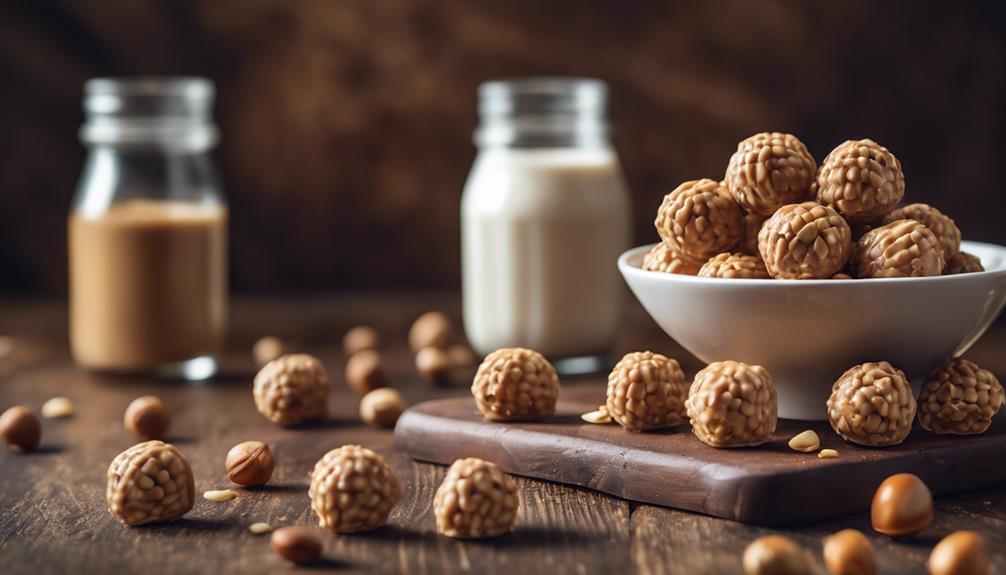
You'll adore these easy and heavenly peanut butter balls. Mix smooth peanut butter, powdered sugar, and vanilla extract for a delectable dough. Roll into small balls and chill. Dip in melted chocolate, then refrigerate to set. Enhance the flavor with rum extract, nuts, or crushed pretzels. Get creative with colorful sprinkles and different chocolate coatings. Use quality chocolate coating and adjust mix consistency. Store them in the fridge or freezer. Enjoy these mouthwatering treats alone or at gatherings. More tips and delightful variations await!
Key Takeaways
- Creamy peanut butter, powdered sugar, and vanilla create a smooth dough.
- Incorporate nuts, rum extract, or pretzels for flavor and texture variety.
- Use quality chocolate coating like candy melts for best results.
- Chill peanut butter balls before dipping for easier handling.
- Store in the fridge or freezer for convenient snacking and serving.
Ingredients and Preparation
To create irresistible peanut butter balls, gather creamy peanut butter, powdered sugar, and vanilla extract as your key ingredients.
Begin by mixing the peanut butter, butter, sugar, and vanilla until you have a smooth dough. Roll this mixture into small balls and chill them before dipping them in melted chocolate.
The type of chocolate you use, such as dark or milk chocolate, will enhance the flavor of your peanut butter balls. After dipping, make sure to refrigerate the balls until the chocolate sets for a perfect finish.
This process guarantees that each bite-sized treat isn't only visually appealing but also bursting with delicious peanut butter and chocolate flavors.
Variations and Enhancements

You can elevate the flavor of your peanut butter balls by incorporating unique ingredients like chopped nuts or rum extract.
Experiment with different chocolate coatings such as white almond bark or dark chocolate candy melts for a varied taste experience.
Get creative by adding finishing touches like colorful sprinkles to make your peanut butter balls visually appealing.
Flavorful Ingredient Additions
Enhance the flavor of your peanut butter balls by incorporating unique ingredient variations and enhancements. While the classic combination of peanut butter, powdered sugar, and butter creates a delicious dough for your treats, you can take it up a notch by adding flavorful ingredient additions.
Consider mixing in crushed pretzels for a salty crunch that complements the sweetness of the peanut butter. Chopped nuts like almonds or pecans can also add a delightful texture and nutty taste to your chocolate-covered peanut butter balls.
For a burst of fruity flavor, try incorporating dried cranberries or raisins into the dough. These additions not only provide a contrast in texture but also introduce a hint of sweetness that pairs well with the creamy peanut butter.
Another option is to include a sprinkle of cinnamon or a dash of vanilla extract to elevate the overall taste profile of your peanut butter balls. Experiment with these flavorful ingredient additions to create a unique and delectable twist on the classic treat.
Chocolate Coating Options
Experiment with different types of chocolate coatings – dark, white, or milk chocolate – to suit your preferences and elevate the flavor of your peanut butter balls.
When considering the chocolate coating for your crunchy peanut butter treats, here are some options to enhance your culinary creation:
- Choose Candy Melts or Almond Bark: Opt for candy melts or almond bark for a smooth and firm chocolate coating that sets well on your peanut butter balls.
- Avoid Chocolate Chips: Steer clear of using chocolate chips for coating, as they may contain stabilizers that hinder smooth melting, affecting the overall texture.
- Add Colored Sprinkles: For a festive touch, sprinkle colored sprinkles on top of the chocolate coating before it sets to add a pop of color and extra crunch to your peanut butter balls.
Experimenting with different chocolate coatings and techniques can take your peanut butter balls to the next level, ensuring a delightful and indulgent treat for any occasion.
Creative Finishing Touches
To elevate the flavor profile of your peanut butter balls, consider incorporating creative finishing touches through various enhancements and unique variations.
You can enhance the texture by adding chopped nuts or crispy rice cereal to the peanut butter mixture, providing a delightful crunch with every bite.
Experiment with different flavors by using almond extract or rum extract instead of vanilla for a twist on the traditional taste.
For a festive touch, roll the balls in crushed graham crackers, sprinkles, or a sprinkle of sea salt to add a pop of flavor.
Drizzle white chocolate over the dark, semi-sweet, or milk chocolate coating for a visually appealing contrast that will impress your guests.
If you enjoy a crunchy element, try coating the balls in crushed pretzels or toasted coconut before the chocolate sets.
These creative enhancements will take your peanut butter balls to the next level, making them a standout treat at any gathering.
Tools and Tips
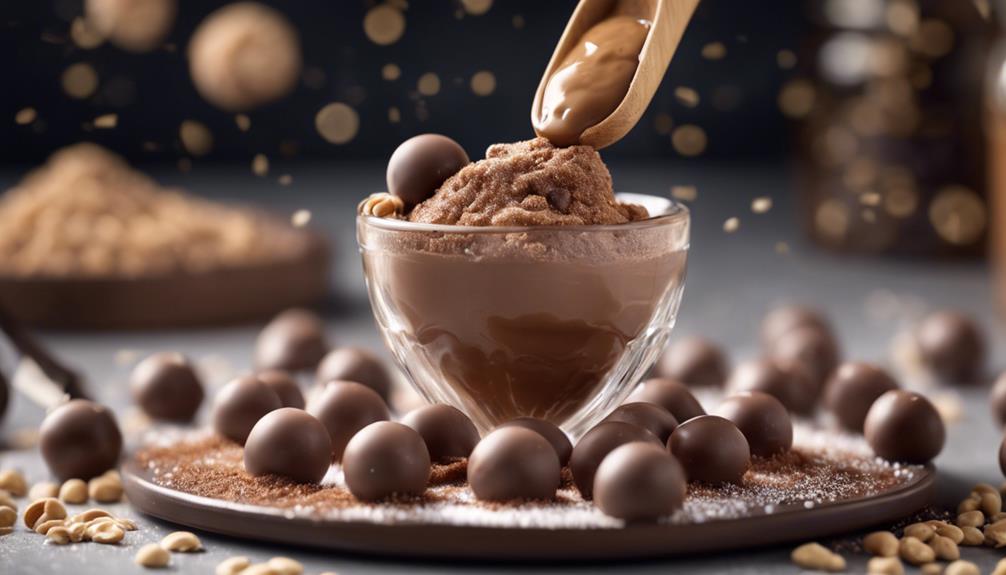
Consider using a 1 tablespoon cookie scoop for consistent sizing when preparing your peanut butter balls. This tool will help guarantee all your treats are uniform in size, making for a neat presentation and even cooking.
Here are some additional tools and tips to enhance your peanut butter ball-making experience:
- Invest in Quality Chocolate Coating: Opt for candy melts or almond bark for a smooth and firm chocolate coating on your peanut butter balls. These coatings melt easily and provide a professional finish to your treats.
- Adjust Peanut Butter Mixture Consistency: If your peanut butter mixture is too sticky or too dry, adjust the consistency by adding more peanut butter or powdered sugar. This will help you achieve the perfect texture for shaping your balls.
- Refrigerate Before Dipping: Prior to dipping your peanut butter balls in chocolate, chill them in the refrigerator. This step will make the balls firmer, making them easier to handle and coat without falling apart.
Storage and Serving Suggestions
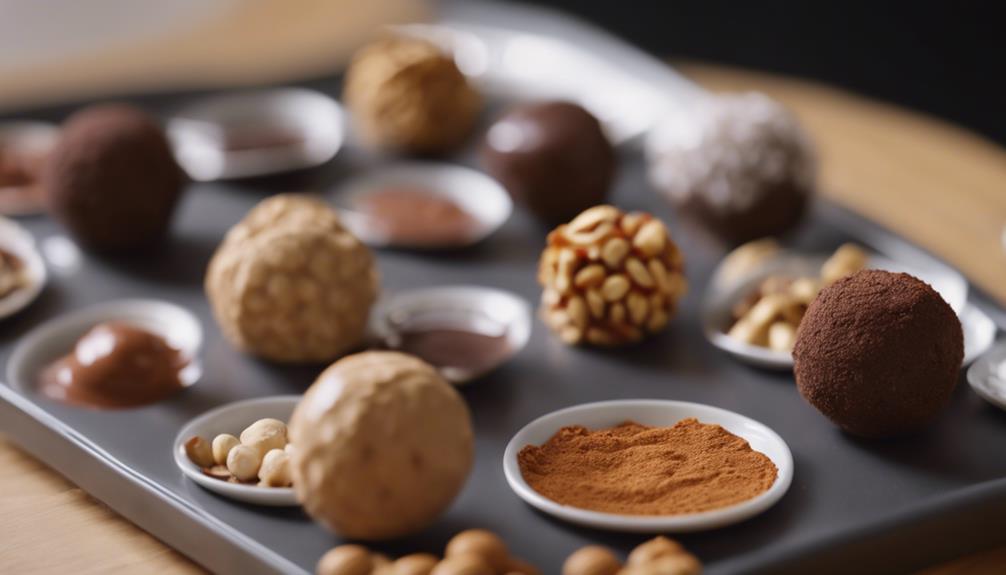
For best freshness and presentation of your peanut butter balls, follow these storage and serving suggestions.
To keep your peanut butter balls tasting delicious, store them properly. You can store them in an airtight container in the fridge for up to 1 week or in the freezer for up to 2 months. When freezing, remember to thaw the frozen peanut butter balls before serving by bringing them to room temperature. To prevent them from sticking together, separate the layers of peanut butter balls with wax paper.
Here is a helpful table summarizing the storage and serving suggestions:
| Storage | Serving | Frozen |
|---|---|---|
| Airtight container | Display on festive tray | Thaw before serving |
| Fridge – 1 week | Pair with hot cocoa | Bring to room temp |
| Freezer – 2 months | Enjoy at holiday gatherings | |
| Separate with wax paper |
Additional Peanut Butter Desserts
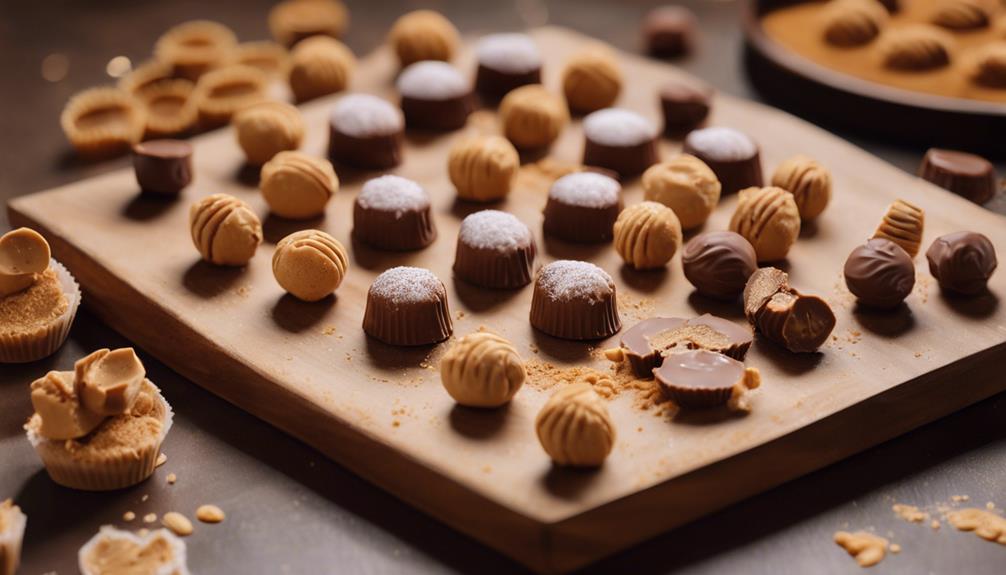
Explore a variety of delectable peanut butter desserts to satisfy your sweet cravings.
- Peanut Butter Blossom Cookies: Indulge in the classic combination of peanut butter cookies topped with a chocolate kiss for a delightful treat.
- Peanut Butter Chocolate Mug Cake: Whip up this easy-to-make single-serving dessert that combines the rich flavors of peanut butter and chocolate in a mug for a quick fix.
- Peanut Butter Overload Cookies: For those who can't get enough peanut butter, these cookies are loaded with peanut butter chips, chocolate chips, and chopped peanuts for an explosion of flavor in every bite.
These additional peanut butter desserts offer a diverse selection to cater to your cravings.
Whether you're in the mood for a classic treat like Peanut Butter Blossom Cookies, a quick fix with Peanut Butter Chocolate Mug Cake, or a flavor-packed experience with Peanut Butter Overload Cookies, there's something for every peanut butter lover.
Enjoy these easy-to-make delights whenever you need a sweet pick-me-up!
Recipe Instructions and Nutritional Information
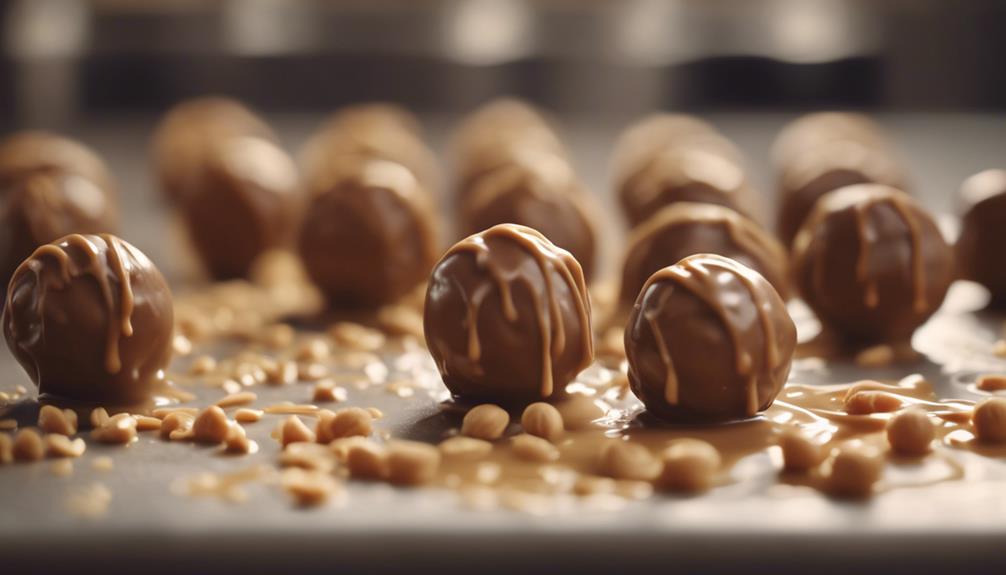
To create these delectable Peanut Butter Balls, start by blending peanut butter, butter, sugar, and vanilla to form a dough. Roll the mixture into small balls and place them on a baking sheet lined with parchment paper. Chill the peanut butter balls in the refrigerator for about 30 minutes until firm.
Once chilled, melt chocolate in a heatproof bowl over simmering water or in the microwave. Dip each chilled peanut butter ball into the melted chocolate, ensuring they're evenly coated. Place the coated balls back on the parchment paper and let the chocolate set.
Each serving of these delightful treats contains approximately 114 calories.
Store the finished peanut butter balls in the fridge for up to 2 weeks or freeze them for up to 3 months.
Enjoy these decadent bite-sized snacks whenever you crave a sweet and nutty indulgence.
Frequently Asked Questions
Can I Use Chunky Peanut Butter Instead of Creamy for This Recipe?
Yes, you can use chunky peanut butter instead of creamy for this recipe. It will add a delightful texture and extra crunch to your peanut butter balls. Enjoy experimenting with different variations!
How Long Do Chocolate Covered Peanut Butter Balls Stay Fresh?
Like a sweet memory, chocolate-covered peanut butter balls stay fresh for up to two weeks when stored in an airtight container in the fridge. Indulge in these delectable treats within that time frame for best taste.
Can I Freeze the Peanut Butter Balls for Later Enjoyment?
Yes, you can freeze the peanut butter balls for later enjoyment. Simply place them in an airtight container or freezer bag. When ready to indulge, let them thaw in the fridge for a few hours.
What Type of Chocolate Is Best for Coating the Peanut Butter Balls?
For coating the peanut butter balls, semi-sweet or milk chocolate works best. They provide a delicious contrast to the creamy peanut butter filling. Simply melt the chocolate, dip the balls, and enjoy the sweet treat!
Can I Add Chopped Nuts or Sprinkles to the Peanut Butter Balls for Extra Flavor?
You can definitely add chopped nuts or sprinkles to the peanut butter balls for extra flavor. It's a great way to customize your treats and add a delightful crunch or colorful touch to each bite.
Conclusion
Indulge in these irresistible peanut butter balls that are sure to satisfy your sweet tooth cravings.
With just a few simple ingredients and easy-to-follow instructions, you can enjoy these bite-sized treats in no time.
So go ahead, treat yourself to a little taste of heaven and experience the perfect combination of creamy peanut butter and rich chocolate.
You won't be able to resist coming back for more!
Sunny’s articles radiate enthusiasm, much like her sunny disposition. As our resident “Butter Geek”, she delves deep into the latest butter trends, ensuring our readers are always in the know. Beyond her writing, Sunny’s passion lies in exploring vegan butter alternatives and hosting butter-tasting soirées.
-

 Recipes & Culinary Uses2 months ago
Recipes & Culinary Uses2 months agoHow Many Sticks of Butter Equals a Pound: A Handy Guide
-

 Shopping Guides1 month ago
Shopping Guides1 month agoWhere to Buy Raw Butter
-

 Recipes & Culinary Uses4 weeks ago
Recipes & Culinary Uses4 weeks agoMake Homemade Butter from Milk at Home
-

 Recipes & Culinary Uses4 weeks ago
Recipes & Culinary Uses4 weeks agoMake Creamy Butter From Buttermilk
-

 Butter Tips and Tricks3 months ago
Butter Tips and Tricks3 months agoHow Long Can You Use Butter After the Expiration Date?
-

 Recipes & Culinary Uses2 months ago
Recipes & Culinary Uses2 months agoMake Your Own Homemade Spray Butter
-

 Butter Tips and Tricks3 months ago
Butter Tips and Tricks3 months agoHow Much Butter to Use Instead of 1/3 Cup Oil
-

 Butter Tips and Tricks3 months ago
Butter Tips and Tricks3 months agoHow Many Calories Are in a Stick of Butter: A Comprehensive Guide




















